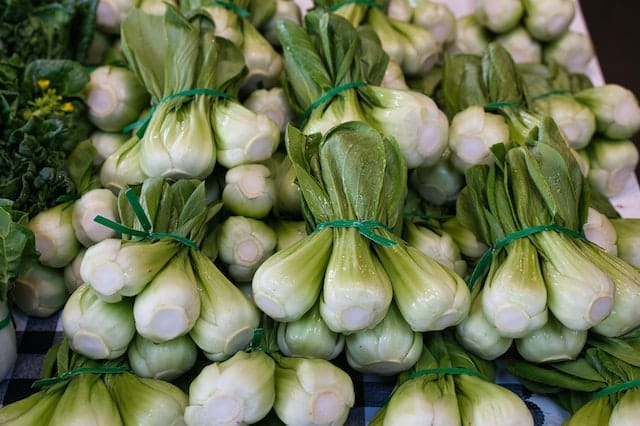No products in the cart.
0 - £0.00
- 0 items
- view cart
No products in the cart.

Looking for a fresh, versatile, and nutrient-dense vegetable to liven up your meals? Look no further than pak choi, an Asian green that has been gaining popularity in the UK for its refreshing crunch and health benefits. In this comprehensive guide, we’ll unravel everything you need to know about pak choi, from what it is, where to find it, its nutritional value, its taste, and of course, how to cook pak choi in your own kitchen.
Pak choi, also known as bok choy, Chinese cabbage, or pok choi, is a type of Chinese cabbage that doesn’t look like your usual cabbage at all. Instead of forming a round or elongated head, pak choi has long, broad, dark-green leaves that cluster together from a base, much like celery or mustard greens. The lower stalks are white and crunchy, while the leafy upper part is soft and has a slightly sweet flavour.
A member of the Brassica family, which includes broccoli, cauliflower, and kale, pak choi is a common feature in East Asian cuisines and is gaining more and more popularity in Western cooking thanks to its crisp texture and versatility in different culinary applications.
Pak choi is readily available in most supermarkets in the UK, especially those with a good selection of fresh produce. You’re also likely to find it in Asian grocery stores, where it’s a staple ingredient. When choosing pak choi, look for bright green leaves and firm white stalks. Avoid any signs of wilting, yellowing, or spots as these are signs of age or poor handling.
Pak choi is a nutritional powerhouse, packed with vitamins and minerals, while being low in calories. It’s an excellent source of Vitamin C, Vitamin A, and Vitamin K. Additionally, pak choi provides a good amount of calcium, potassium, and folate. Its high water content also contributes to its low calorie count, making it an ideal choice for those mindful of their calorie intake.
One of the great things about pak choi is its versatility. It can be enjoyed raw in salads, quickly cooked in stir-fries, or slowly braised in a rich sauce. Pak choi can be prepared using a variety of cooking methods. Whether you prefer it crisp and fresh or tender and deeply flavoured, here are some methods to consider:
Sautéing is a quick and straightforward method that brings out the fresh taste of pak choi.
Steaming pak choi is another healthy and quick way to prepare this vegetable, preserving its crunchiness and bright green colour.
For a softer, more flavour-infused pak choi, try braising.
Grilled pak choi is a unique and flavourful option when it comes to how to cook pak choi, especially during the summer months.
Each of these methods offers a different way to enjoy pak choi, allowing its flavours to shine while adding a unique twist. Whether you like it best lightly sautéed, steamed, braised, or grilled, pak choi is a versatile ingredient that’s sure to please in any dish.

Pak choi has a fresh, slightly sweet flavour with a hint of mustard. The white stalks are crisp and juicy, while the leafy parts are tender and slightly bitter, similar to spinach or mustard greens.
Yes, you can eat pak choi raw. Its crisp texture and mild flavour make it a great addition to salads and slaws.
Pak choi is low in calories and rich in vitamins A, C, and K. It also provides a good amount of calcium, potassium, and folate, making it a nutritious choice.
Store pak choi in the crisper drawer of your refrigerator, ideally in a plastic bag with a few holes to allow for air circulation. It should last for about a week.
There’s no difference – pak choi and bok choy are two different names for the same vegetable. The names come from different Chinese dialects.
Yes, pak choi is a versatile vegetable that can be used as a substitute for other leafy greens like spinach, swiss chard, or napa cabbage in many recipes.
Yes, pak choi is a plant-based food and is suitable for a vegan diet. It can be prepared in many creative, vegan-friendly ways.
Pak choi is available in most large supermarkets, Asian grocery stores, and online gourmet food shops in the UK.
Yes, the entire pak choi plant is edible. The white stalks have a satisfying crunch, while the dark green leaves are tender and slightly bitter.
⭐️⭐️⭐️⭐️⭐️ Plant Sumo’s Soul Curry has been the perfect fully plant based substitute for my favorite curry dishes and I look forward to this option with each order :) – Lydia Sims
Plant Sumo is a part of the Pearl Lemon Group . We also run three Cafe’s – Pearl Lemon Café (w/lots of plants), Pearl Lemon Catering, Pearl Lemon Boba, and How Matcha (come visit) in London!
© All Rights Reserved | Company Number: 10411490 | VAT Number: 252 7124 23 | Sitemap